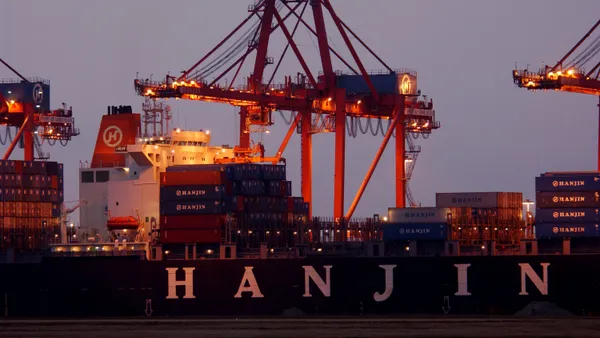Dive Brief:
- Transit times for Columbia Sportswear's inventory doubled to six weeks in Q3 as U.S. port congestion and limited trucking availability has kept its distribution centers waiting for product to arrive, Tim Boyle, president, chairman and CEO of the company, said on an earnings call.
- The logistics delays caused Columbia's in-transit inventory to increase 127% YoY, while finished goods inventory in distribution centers was down 35% YoY, according to its earnings presentation.
- Columbia has product encountering delays at the many different port cities it ships to, including Portland, Oregon, Savannah, Georgia, as well as Los Angeles, Long Beach and Seattle. The bulk of its fall merchandise (more than 90%) has been shipped, but just about 70% has been received, with some still "on the water or coming through a port," Boyle added.
Dive Insight:
Supply chain bottlenecks at U.S. ports, particularly in San Pedro Bay, have sparked attention from the White House and spurred initiatives from a host of stakeholders to accelerate cargo velocity as consumer demand remains high.
Columbia's in-transit inventory challenges are "unfortunately happening at a time when the brand is incredibly popular and selling very well," Boyle said. The company is expanding its distribution capacity and improving its inventory management to bolster its own supply chain capabilities, but that doesn't solve upstream obstacles.
"So we are turning around this merchandise as it gets into our distribution centers as fast as possible. And the constraints are not necessarily in our DCs, but rather in waiting for the merchandise to arrive from the ships," Boyle said, adding that deliveries in Canada and Europe have been "much more timely."
Other supply chain stakeholders are calling on shippers to do more to help ease congestion. Eric Gehringer, executive vice president of operations at Union Pacific, said in an earnings call that the railroad can handle the volume from the ports, but shippers and truckers need to remove and return containers quicker.
"We need the back end of the supply chain with warehouse capacity, warehouse labor, dray capacity and dray labor to be there to answer that call," Gehringer said.
In its earnings presentation, Columbia pointed to shortages in trucks, drivers and equipment as to why some fall inventory shipments have been delayed. Additionally, Columbia has been "light" on labor at its distribution centers, according to Boyle, a common problem for retailers as e-commerce demand surges.
Order cancellations from Columbia's customers have been minimal due to heightened demand, which gives the company confidence that it can pass on heightened inbound shipping costs and manufacturing costs to its customers.
"Now there's a shortage of product," Boyle said. "And our expectations are that we'll be able to fully pass on these price increases to consumers."
Other retailers have expressed the same sentiment: A study from First Insight and the Wharton School's Baker Retailing Center found 98% of surveyed retail executives are experiencing supply chain issues, and 59% are hiking consumer prices to mitigate the newfound costs.














